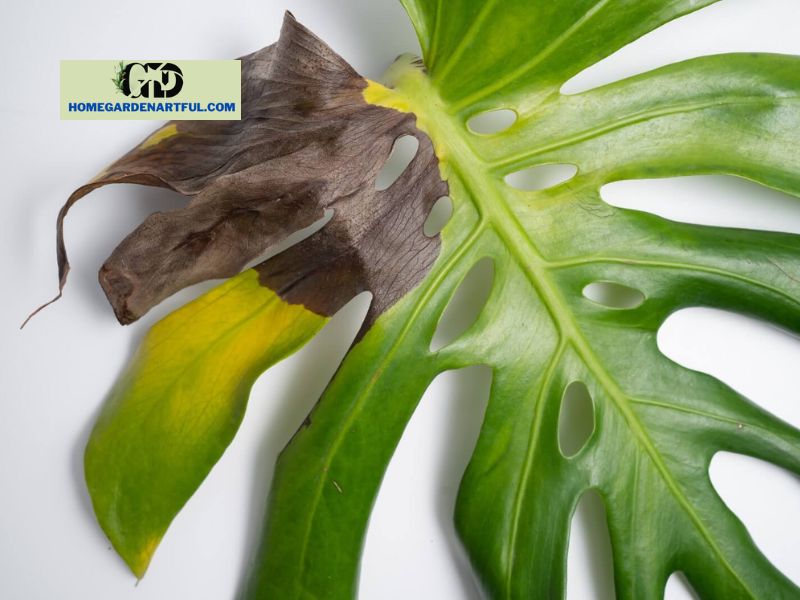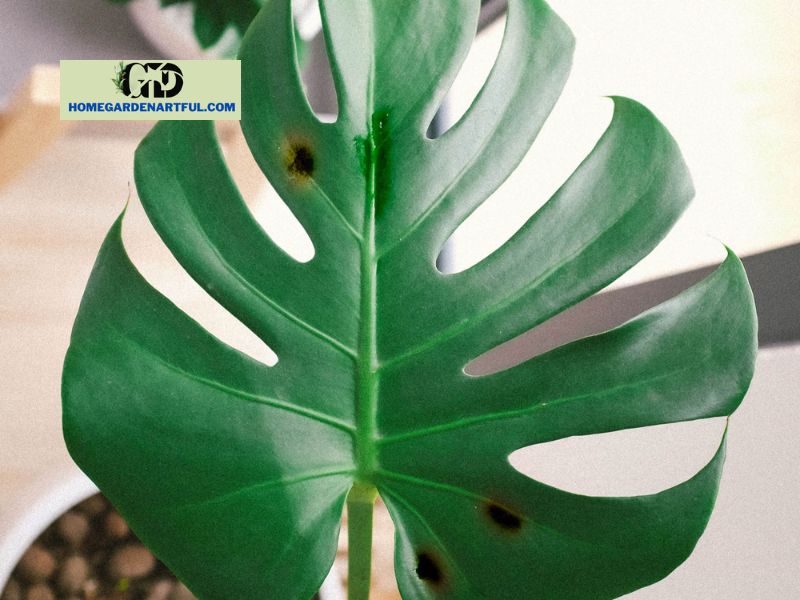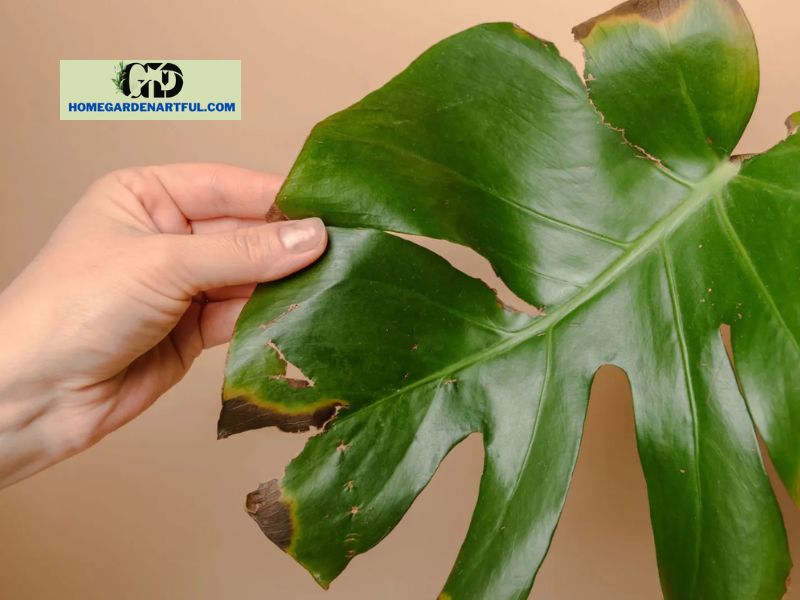Monstera Leaves Turn Black, what should you do? Monstera, known for its deeply lobed, massive green leaves, can be harmed by this unjust approach, turning the edges of the leaves yellow and black.
So continue reading at homegardenartful.com to learn more about the origins and solutions to the problem.
Monstera Leaves Turn Black: Cause And Solutions

Monstera, despite being a tough and hardy plant, is not without flaws.
After a certain stage, the quality and quantity of variables such as light, soil, water, and humidity may fluctuate, resulting in black spots on Monstera leaves.
Fortunately, if caught early enough, the illness can be reversed.
1. Improper Watering
Overwatering and underwatering are both to blame for the blackening of the Monestra leaves.
It may be difficult to determine what is wrong with your Monstera because the plant exhibits similar symptoms in both problems.
There are, however, distinctions that are plainly discernible.
You can remedy the condition by placing the pot in direct sunlight for a day and then bringing it indoors.
Also, if the roots are mushy, use a sterile knife to chop off all the damaged areas. The plant should then be repotted into a new potting mix.
Underwatering, on the other hand, causes drooping, crispy, dry, and yellowing leaves that eventually develop into black patches.
To do so, immediately water the Monstera with tepid water or saturate the pot for around 15-20 minutes then drain excess water.
2. Improper Lighting

Sunburn and a lack of sunlight are two other causes of Monstera leaves becoming black.
However, if they are exposed to direct, searing sunshine, their leaves become brown and black.
You can treat the sunburn by readjusting the plant’s shades, drawing a curtain in the window, or moving it to an east-facing window.
Additionally, low light intensity promotes chlorophyll pigment loss, which results in the yellow tint of leaves.
It reduces photosynthesis and disrupts the entire physiological process of plants. As a result, Monstera leaves turn black to indicate stress.
Install a grow lamp and provide the plant with 1-2 hours of afternoon and morning rays to adjust the lighting effect.
3. Fertilizing Problems
Monstera exhibits a need for feeding or excessive fertilizer use via black leaf patches, which should be investigated quickly.
Monstera nutritional deficits cause regressive development and the emergence of black spots, making the plant weak and susceptible to disease and pest assault.
However, do not overfertilize them as this creates excessive salt accumulation, which causes scorching and blackening of the leaves.
Wash out excess fertilizer by immersing the pot in a pool of water for about 30 minutes, and report if the soil is beyond remedy.
4. Temperature Stress
Monstera-like temperatures range from 60 to 80 degrees Fahrenheit. Temperatures above or below the range, as well as temperature fluctuations, cause Monstera leaves to turn black.
The quick loss of moisture and drying of leaves caused by high temperatures results in a black patch.
Balance the excessive temperature by watering the foliage on a regular basis and bringing the plant indoors if it is outside.
It is therefore preferable to use a frost blanket, and a heating mat under the pot, and to prevent drafty areas as well as heating and cooling vents such as heaters, radiators, and so on.
Mulch can also be used to minimize warmth loss from the soil and to insulate the Monstera plant.
5. Unfavorable Humidity

As a tropical plant, Monstera prefers high humidity levels of 60-70%.
Because low humidity promotes excessive transpiration in Monstera, the leaves turn black.
So, use an electric humidifier or arrange the plants together to increase the humidity surrounding the plant.
You may also water the Monstera every 3-4 days or keep it moist by placing pebble trays beneath the container.
However, allowing the humidity to exceed the range increases the likelihood of mold formation as well as fungal growth, turning the leaves yellow and black.
6. Pests and Disease Infestation
Another factor that causes Monstera leaves to turn black is the presence of common pests such as aphids, white flies, spider mites, scales, thrips, and fungus gnats.
Look for damaged leaves, dark spots under the leaves, and then yellow larvae on the top to confirm their presence.
If the infestation is out of control, treat the plant with insecticidal soap and neem oil.
Meanwhile, black spots emerge when your Monstera is infected with diseases such as anthracnose, bacterial leaf spots, and root or stem rot, which are typically caused by wet soil.
As a result, it’s best to remove any leaves with black spots as soon as you detect them, as they’re contagious.
Also, apply a copper-based fungicide to the damaged Monstera and repot the plant to eliminate all brown, mushy roots.
7. Wrong Soil Mix
Toxins in the soil, such as lead, petroleum compounds, radon, arsenic, creosote, and others, are toxic to Monstera.
These pollutants have a negative impact on Monstera’s root, nutrient absorption, as well as overall physiological function. As a result, the leaves of the plant turn black.
A soil pH in the 5.5-7 range is also required for Monstera nutrition uptake and growth.
To keep the pH stable, use a well-draining, nutrient-rich soil mix with cottonseed meal, coffee grounds, and pine bark.
Final Thought
To keep your Monstera problem-free, always maintain appropriate humidity, fertilization frequency, temperature, wetness, and light.
Work on your problem today as well as fix your Monstera; otherwise, it will welcome new problems such as curled leaves and leggy-looking Monstera.


